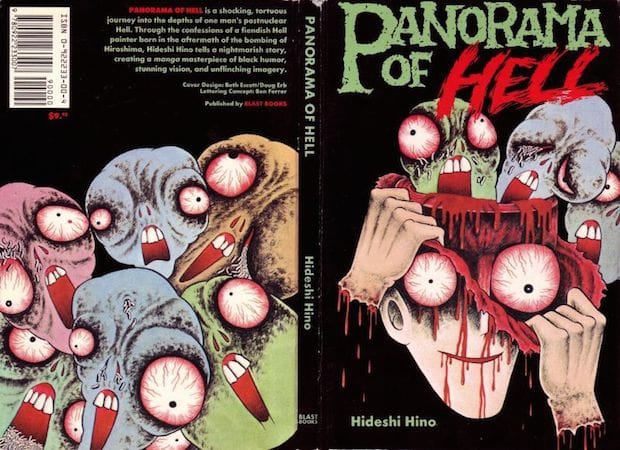Dark and gruesome but with a fair dash of humour, it’s clear to see the parallels between Hideshi Hino's Panorama of Hell and Zeke Clough’s artwork for Shackleton and Appleblim's Skull Disco imprint. Clough explains its cutely morbid appeal. The first time I saw any images from Hideshi Hino's Panorama of Hell was around 1990, in the pre-internet days of crappy, photocopied zines, murky little stamp-sized images of cartoon trauma – a graphic novel about a horror artist, painting in his own blood. The combination of the almost-cute character design and the feel that it was all happening in the early hours of some poor sod's 'dark night of the soul' appealed.
Then I was able to buy a copy of Blast Book's English translation and see the lurid colour cover, quite something after those grainy photocopies. The contrast between the macabre and the cute even more pronounced. Sure the main protagonist is peeling off his own face, but look at that daft grin he's sporting, he looks almost bashful. As for those maggots, they look harmless enough, even to someone as squeamish as me.
The free-floating heads of damned souls smeared across the back cover, endlessly tormented with their bloodshot eyes and wonky teeth. All good natured comic apocalypse until you read in the back cover blurb that Hideshi Hino was born in the aftermath of the Hiroshima bombing and according to Wikipedia was almost killed as a child when his family was forced to flee from China to Japan. Experiences way beyond the scope of my understanding or imagination, but I understand that this comic horror show has its basis in fact.
Tumorous, humorous cartoons vs the everyday apocalypse of post-war hell. It’s a lesson in how to deal with difficulties in your own life by descending into a distorted mirror world of psychedelic horror and reporting back with your observations.
Style-wise, I'm a sucker for Hino's technique, you can see on the severed wrists how he shades almost up to the edge, but leaves a strip free of tone. It’s a subtle effect that gives the impression of a raised area of slightly swollen flesh. Then see how he shades around those bulbous, reddened eyes, so they almost float free from the heads like poached eggs with a tiny black yolk pupil and lashings of veins. A glutinous approach to portraiture.
Then there's the teeth, from looking at examples of Japanese Yōkai art, particularly the few glimpses I've had of vintage stickers, it seems this wonky teeth stylisation was utilised by other anonymous artists as well. It's a winning effect: the crescent moon eyes on the blue head on the front cover, mixed with those crazy teeth gives me an impression of drunken delirium. I have tried in vain to mimic this in my own work, but like many deceptively simple things, it's easy to copy, impossible to duplicate.
Should you have the inclination to explore Hino's world, I'd strongly recommend it, don't be put off by the occasional bouts of predictability in some of his books, but hold out for twilight zone atrocities like The Red Snake, Hell Baby and my personal favourite, the septic psychedelia of Zoroku's Strange Disease. It’s perhaps my favourite comic strip, a crystallised Kafkaesque nightmare. If only I could get my paws on Hino's vinyl figure version of Frankenstein's monster, it's beautiful.
Zeke Clough
… is the illustrator behind the dark, comic-inspired artwork that gave now-defunct electronic music label Skull Disco (founded by producers Shackleton and Appleblim) such a distinctive visual style. Since Zeke has also worked on music-related projects for Mordant Music, with which he published a twentyfour—page comic Hard Shoulder last year.
Yōkai
These otherworldly figures are a type of supernatural monster or spirit found in Japanese folklore. The word is a combination of the characters yō, which means attractive or bewitching and kai, meaning wonder. Sometimes good and sometime malevolent, the yōkai can also ghosts, gods, humans that have been transformed into animals, possessed humans and other strange phenomena. Although they date back to the earliest recorded Japanese stories, yōkai experienced a surge in popularity during the Edo Period (1603-1868) when the work of Toriyama Sekien, an artist who collected the oral traditions of rural Japan and produced illustrated bestiaries for the growing urban market, began to be more widely distributed.
August 14, 2014 3 minutes read
Horror Show
Dark and gruesome but with a fair dash of humour, it’s clear to see the parallels between Hideshi Hino's Panorama of Hell and Zeke Clough’s artwork for Shackleton and Appleblim's Skull Disco imprint.

